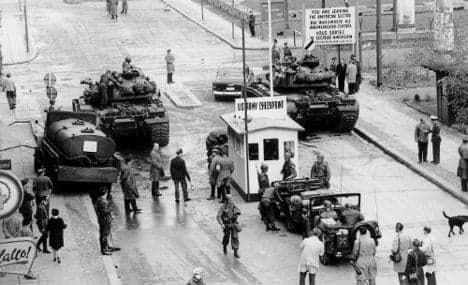Checkpoint Charlie

Few locations came to symbolise divided Berlin like the Allied border crossing Checkpoint Charlie. Despite its important role in the Cold War years, nothing of the original structure remains in place and the downtown site is now overrun by the tourist trade.
Checkpoint Charlie then
Checkpoint C, most commonly known as Checkpoint Charlie, was a border crossing point that stood at the corner of Friedrichstrasse and Kochstrasse in central Berlin. It was established as soon as Berlin was divided and became the site of a famous stand-off between Soviet and American tanks after the construction of the Wall in 1961. Afterwards, it became an international symbol of Berlin’s division.
As the years of division passed, this checkpoint became increasingly asymmetrical. Soviet troops built an extensive network of zig-zag barriers, a watchtower and a multi-lane car shed, across from the relatively bare Western allied checkpoint. The site became the crossing point for Allied forces, and one of only two for foreign travellers.
The site was the backdrop to several Cold War tragedies, including the escape attempt by East German teenager Peter Fechter. Trying to flee to the West in August 1962, Fechter was shot down by border guards. Lying next to the barbed wire on the Eastern side, Fechter was left to die, as Western troops could not enter and Eastern guards were afraid to approach.
The image and story of Peter Fechter became, and remains, one of the most well-known reminders of the brutality of the Berlin Wall. His death triggered massive protests and the construction of a memorial, which still stands today.
Even after the wall came down, Checkpoint Charlie remained an official crossing point until full German reunification almost a year later.
Checkpoint Charlie now
Checkpoint Charlie today is one of Berlin’s most famous stops on sightseeing tours. The private museum Haus am Checkpoint Charlie has long been a favourite with visitors, even though the official Wall memorial and documentation centre on Bernauerstrasse is far more comprehensive.
“The museum seems to be frozen in time – it gives the impression that the Wall is still outside,” Dr Axel Klausmeier, director of the Berlin Wall memorial foundation, told The Local.
Despite the tourist attention still given to the site, nothing of the original checkpoint remains after the final watchtower was torn down in 2000. The guard house that now marks the checkpoint is a replica of the original from 1961.
“It is a very difficult place in a way, but seems to be something tourists are interested in. The checkpoint produced lots of images in our collective memory, and, as an allied checkpoint, saw many international visitors,” Klausmeier said.
Comments
See Also
Checkpoint Charlie then
Checkpoint C, most commonly known as Checkpoint Charlie, was a border crossing point that stood at the corner of Friedrichstrasse and Kochstrasse in central Berlin. It was established as soon as Berlin was divided and became the site of a famous stand-off between Soviet and American tanks after the construction of the Wall in 1961. Afterwards, it became an international symbol of Berlin’s division.
As the years of division passed, this checkpoint became increasingly asymmetrical. Soviet troops built an extensive network of zig-zag barriers, a watchtower and a multi-lane car shed, across from the relatively bare Western allied checkpoint. The site became the crossing point for Allied forces, and one of only two for foreign travellers.
The site was the backdrop to several Cold War tragedies, including the escape attempt by East German teenager Peter Fechter. Trying to flee to the West in August 1962, Fechter was shot down by border guards. Lying next to the barbed wire on the Eastern side, Fechter was left to die, as Western troops could not enter and Eastern guards were afraid to approach.
The image and story of Peter Fechter became, and remains, one of the most well-known reminders of the brutality of the Berlin Wall. His death triggered massive protests and the construction of a memorial, which still stands today.
Even after the wall came down, Checkpoint Charlie remained an official crossing point until full German reunification almost a year later.
Checkpoint Charlie now
Checkpoint Charlie today is one of Berlin’s most famous stops on sightseeing tours. The private museum Haus am Checkpoint Charlie has long been a favourite with visitors, even though the official Wall memorial and documentation centre on Bernauerstrasse is far more comprehensive.
“The museum seems to be frozen in time – it gives the impression that the Wall is still outside,” Dr Axel Klausmeier, director of the Berlin Wall memorial foundation, told The Local.
Despite the tourist attention still given to the site, nothing of the original checkpoint remains after the final watchtower was torn down in 2000. The guard house that now marks the checkpoint is a replica of the original from 1961.
“It is a very difficult place in a way, but seems to be something tourists are interested in. The checkpoint produced lots of images in our collective memory, and, as an allied checkpoint, saw many international visitors,” Klausmeier said.
Join the conversation in our comments section below. Share your own views and experience and if you have a question or suggestion for our journalists then email us at [email protected].
Please keep comments civil, constructive and on topic – and make sure to read our terms of use before getting involved.
Please log in here to leave a comment.